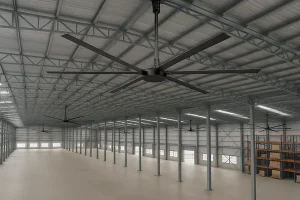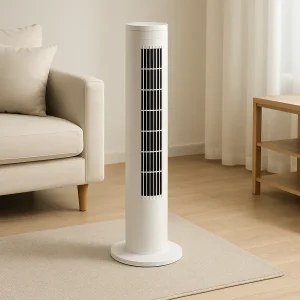Struggling with stuffy rooms and soaring energy bills? Traditional air conditioning can be costly, and standard fans often just push hot air around, especially in larger spaces. Finding an effective Und economical cooling solution feels like an impossible task.
The most economical fans balance initial purchase price with long-term energy consumption and cooling effectiveness for the intended space. Options range from budget-friendly Tischventilatoren for personal cooling to Turmventilatoren Und Standventilatoren for rooms, and highly energieeffizient High-Volume Low-Speed (HVLS) fans, like those we manufacture, designed for maximum air circulation in large areas like warehouses and factories with minimal Energieverbrauch. Choosing depends on space size, required airflow, and features.

HVLS Fans keeping a large warehouse cool
When you’re looking for the best fan, especially an economical one, it’s easy to just grab the cheapest option. But true economy isn’t just about the upfront cost. We need to look at the bigger picture: energy usage, lifespan, and how well the Lüfter actually does its job – keeping you Cool. A fan that uses a lot of electricity or needs replacing every year isn’t truly economical, even if it was cheap to buy.
Think about Energieverbrauch. A fan might run for hours every day during warm months. Even small differences in wattage can add up significantly on your electricity bill. Look for fans with Energy Star ratings or those specifically marketed as energieeffiziente Ventilatoren. Features like variable speed settings also contribute; running a Lüfter on a lower setting uses less power. Consider how long the Lüfter is likely to last. A well-built Standventilator oder ein robustes tower fan might cost more initially but save money in the long run by avoiding replacements.
This is a common dilemma! Both Turmventilatoren Und Standventilatoren are popular choices for cooling rooms, but they offer different advantages. Tower fans, with their slim, vertical design, often blend better into modern decor and take up less floor space. Many Turmventilatoren come with features like remote controls, timers, and multiple speed settings. They typically oscillate to distribute kühle Luft over a wider area. We’ve tested many tower fans we tested, and their value often lies in this combination of features and aesthetics.
Standventilatoren, on the other hand, often have larger blades and potentially more powerful motors, allowing them to move more Luft um at higher speeds. This can make them feel more effective at providing a direct breeze and achieving faster Luftzirkulation in einem large room. While some models can be basic, many modern Standventilatoren also offer oscillation and adjustable height/tilt. In terms of pure airflow per dollar, a simple Standventilator might seem more economical, but a feature-rich tower fan might provide better overall comfort and convenience, making it the best combination for some users. Consider the specific fan offers and your room’s needs.

Slim tower fan for home use
Bladeless fans, like those popularized by Dyson, look futuristic and are often touted for safety (no spinning blades) and smooth airflow. They work by drawing air into the base and projecting it out through a ring or slot. But are they truly economical? While their bladeless design is sleek and potentially safer for kids and pets, they often come with a significantly higher price tag compared to traditional Turmventilatoren oder Standventilatoren.
From an Energieeffizienz standpoint, bladeless fans aren’t always clear winners. Their energy consumption can be comparable to, or sometimes even higher than, a standard tower fan providing similar airflow. The perceived “smoothness” of the air might feel pleasant, but it doesn’t necessarily mean they Cool A whole room more effectively or economically. You’re often paying a premium for the design, brand name, and sometimes added features like an integrated air purifier. If budget is the primary concern, a good tower fan oder Standventilator often provides better cooling value.
Vornado fans aren’t typical oscillating fans; they are marketed as air circulators. Instead of just blowing air directly at you, Vornado units are designed to create a vortex-like airflow that circulates all the air around the room, creating a more consistent Temperatur des Raumes without a harsh draft. We find the Vornado approach interesting. Their signature “Vortex Action” aims to move Luft um more effectively, potentially allowing you to feel Cool even at a higher thermostat setting if using Klimaanlage.
Compared to a standard oscillating fan, A Vornado air circulator aims for whole room comfort rather than just spot cooling. This can be more energieeffizient in the long run if it allows you to rely less on your Klimaanlage. However, Vornado fans often lack oscillation (by design) and might have a higher initial cost than basic Standventilatoren oder Tischventilatoren. Der Vornado 660 is a popular whole room air circulator model often praised for its power. Whether a Vornado is the most economical choice depends on if you value whole room air circulation over directional cooling and are willing to invest a bit more upfront for potential long-term energy savings. They are definitely a unique Lüftertyp.
Finding an energy-efficient fan is key to keeping costs down while staying Cool. Here’s what to consider:
Energy Star Rating: While less common for portable fans than for Deckenventilatoren or appliances, an Energy Star label guarantees a certain level of Energieeffizienz.
Wattage: Check the product specifications for power consumption (measured in watts). Lower wattage generally means lower Energieverbrauch. Compare wattage across fans with similar airflow (CFM – cubic feet per minute) if possible.
DC Motors: Fans with DC (Direct Current) motors are typically significantly more energieeffizient than traditional AC (Alternating Current) motors, often using up to 70% less energy. They are becoming more common in premium Turmventilatoren, Standventilatoren, Und Deckenventilatoren.
Multiple Speed Settings: Having several Lüftergeschwindigkeit options allows you to use the lowest effective setting, saving energy. A Lüfter running on low might use less than half the power it does on high.
Timers: A timer lets you set the Lüfter to turn off automatically after a certain period, preventing it from running unnecessarily (e.g., after you’ve fallen asleep).
Right Size for the Space: Using a small desk fan to try and Cool A large room is inefficient. Conversely, using a huge, powerful Bodenventilator on high speed in a tiny room might be overkill and use more energy than needed. Matching the fan’s power and type (e.g., tower fan, Standventilator, air circulator) to the room size ensures optimal performance and efficiency.
Considering these factors will help you find the best balance between cooling power and energy savings, leading to a truly economical choice.
Yes, absolutely! For personal cooling, a desk fan can be incredibly economical. These small fans are designed to provide a direct breeze over a short distance, perfect for keeping you Cool while working at a desk or relaxing in a specific spot. Because they are small and move less air overall than a tower fan oder Standventilator, their Energieverbrauch is typically very low.
A desk fan won’t cool an entire room, but that’s not its purpose. It provides targeted relief exactly where you need it. This means you might not need to lower the Klimaanlage für die whole room, saving significant energy. Many Tischventilatoren are very affordable to purchase, making them a great budget option. Look for models with adjustable tilt and multiple speed settings for added control. While simple, a good desk fan is often the most cost-effective way to stay cool in a localized area. They are a basic but effective elektrischer Ventilator.
Bodenventilatoren typically refer to larger, more powerful fans that sit directly on the floor, often with large blades housed in a cage-like grille. They are generally designed to move a lot of air, making them suitable for larger spaces or areas needing robust Luftzirkulation, like garages or workshops. Think of high-velocity Bodenventilatoren.
Their power often comes at the cost of higher Energieverbrauch compared to smaller Tischventilatoren or many Turmventilatoren. While effective at creating a strong breeze and moving air around, they might not always be the most economical choice for standard room cooling, especially if run constantly on high speed settings. However, in situations where you need maximum airflow quickly, or to ventilate a larger area without installing Deckenventilatoren, A Bodenventilator can be a cost-effective alternative to more expensive cooling methods. Some modern Bodenventilatoren offer better Energieeffizienz than older models, so checking the wattage is still important. They represent a trade-off: more power, potentially higher running costs.
Now, let’s talk about truly large spaces – think factories, warehouses, gyms, Gewerbebauten, and expansive retail areas. In these environments, standard Turmventilatoren, Standventilatoren, or even multiple Bodenventilatoren struggle to provide adequate and economical air movement. This is where High-Volume, Low-Speed (HVLS) fans come into play.
As manufacturers specializing in air movement solutions like HVLS-Ventilatoren, we know firsthand the impact they can have. HVLS fans use very large blades (from 8 feet up to 24 feet in diameter) rotating at a low speed setting. This design is incredibly energieeffizient for the massive volume of air they move. Instead of creating small pockets of turbulent, high-velocity air like a small Lüfter, HVLS fans create a broad, gentle column of bewegte Luft that spreads across a vast area.

HVLS-Ventilator für gewerbliche Räume
Why are they economical for large spaces?
Massive Coverage: One HVLS fan can often replace dozens of smaller, less efficient fans, drastically reducing the number of units needed.
Low Energy Consumption: Despite their size, HVLS fans typically use surprisingly little power – often comparable to a few standard Standventilatoren – thanks to optimized blade design and efficient motors. This leads to significant energy savings compared to running many small fans or relying heavily on HVAC systems. Check out how much power an HVLS fan uses.
Improved Comfort & Productivity: By creating gentle, consistent Luftzirkulation, they improve thermal comfort over large areas, which can boost productivity and morale in workplaces like Produktionsanlagen or keep customers comfortable in commercial settings.
Year-Round Benefits: In winter, running HVLS fans in reverse (destratification) pushes trapped warm air down from the ceiling, reducing heating costs.
While the initial investment for an HVLS fan is higher than for a portable Lüfter, the long-term energy savings and operational benefits make them arguably the most economical solution for effectively managing air in large commercial, industrial, and landwirtschaftlich environments. They are a specialized but highly effective Lüftertyp for specific needs.
After tested dozens of fans, considering factors like cooling power, noise level, features, energy efficiency, and overall value, here are some standouts shaping up to be among the 9 best fans (and more) for 2025:
Best Overall Tower Fan: Der [Brand X Signature Tower Fan] consistently impresses. It offers a great best balance of power, quiet operation across its multiple speed settings, wide oscillation, and includes a handy fan with remote. It’s an excellent choice for a living room or bedroom. It represents the best tower value we’ve seen.
Most Powerful Pedestal Fan: For sheer airflow, the [Brand Y Power Pedestal] moves a serious amount of air. While potentially louder on high settings, its adjustable height and tilt make it versatile for larger rooms or workshops where maximum cooling is prioritized over silence. It’s the best for raw power in its class.
Top Air Circulator: Der Vornado 660 Whole Room Air Circulator remains a strong contender. Its ability to create even Luftzirkulation throughout an entire room without oscillation is unique and effective. Great for those who dislike direct drafts but want consistent cooling. Vornado knows Luftzirkulation.
Best Budget Tower Fan: Der [Brand Z SlimCool Tower] provides decent cooling and oscillation at a very attractive price point. While it might lack some bells and whistles of premium models, it’s a solid cooling fan that gets the job done economically. This tower fan is great value.
Quiet Desk Fan Champion: Der [Brand A WhisperDesk] is perfect for office or bedside use. It’s incredibly quiet, especially on lower speed settings, yet provides a noticeable personal breeze. Its low Energieverbrauch makes it super economical.
Premium Bladeless Option (with Air Purifier): While pricey, the [Dyson Purifier Cool TP09] combines bladeless fan technology with HEPA filtration. If you need both cooling and air purification, this best combination might justify the cost, though it’s less economical purely for cooling. It has a built-in air purifier.
Versatile Floor Fan: Der [Brand B AirMover 3000] offers multiple speed settings and a pivoting head, making it adaptable. It bridges the gap between standard Standventilatoren and high-velocity industrial fans. Good for garages or large living areas.
Economical Window Fan: For drawing in Cool night air or exhausting stale air, the [Brand C Twin Window Fan] is highly effective and uses minimal energy. Some models are reversible and have thermostat controls.
Ultimate Large Space Solution (Our Expertise): For warehouses, factories, gyms, or large commercial spaces, Vindus M650/M750 Series HVLS Fans represent the peak of economical large-scale air movement. Unmatched Energieeffizienz for the volume of air moved, providing comfort and significant operational savings. This is where we, as manufacturers, excel in providing value.
Denken Sie daran, die bester Fan always depends on your specific needs, room size, and budget. These picks represent some of the top fans on the market for various categories in 2025.
Some modern fans, particularly higher-end Turmventilatoren Und bladeless fans, come with integrated HEPA filters, essentially combining a cooling fan mit einem air purifier. This seems like a convenient 2-in-1 solution, but is it cost-effective?
The initial cost of these combo units is usually significantly higher than a standard Lüfter of similar cooling capacity. You’re paying for both the fan mechanism and the filtration technology. Additionally, you need to factor in the recurring cost of replacing the filters (HEPA and sometimes carbon filters), which can add up over time. While they do save space compared to having two separate devices, they might not be the most economical choice if your primary need is just cooling. A dedicated air purifier and a separate, more affordable tower fan oder Standventilator might be cheaper both upfront and in the long run, especially considering filter replacement costs. However, if space is tight and you value both functions highly, the convenience of a combo unit like a tower fan with remote and purification might be worth the premium.
Which type of fan uses the least electricity?
Generally, Tischventilatoren use the least electricity due to their small size and motors. Among larger fans, those with DC motors are significantly more energieeffizient than traditional AC motor fans. HVLS fans, despite their size, are exceptionally energy-efficient for the volume of air they move in large spaces.
Are tower fans better than pedestal fans for cooling?
Neither is definitively “better”; they serve slightly different purposes. Tower fans often offer wider oscillation and a sleeker design, blending well into rooms. Standventilatoren may offer more powerful, direct airflow thanks to larger blades. The bester Fan depends on whether you prioritize aesthetics and distributed air (tower fan) or potentially stronger directional cooling (Standventilator). Many find a good tower fan provides the best balance of power and features for typical rooms.
Do fans actually cool the air?
No, fans don’t lower the air temperature like an Klimaanlage. They work by creating airflow, which enhances the evaporation of sweat from your skin (evaporative cooling), making you fühlen cooler. They also Luft zirkulieren, preventing stagnant hot spots and distributing kühle Luft if there’s a source (like an open window at night or existing Klimaanlage).
How much difference does fan speed make to energy use?
It makes a significant difference. Running a Lüfter on its lowest speed setting can use considerably less energy (often less than half) compared to running it on its highest setting. Using the appropriate Lüftergeschwindigkeit for your needs is crucial for maximizing Energieeffizienz.
Is it cheaper to run a fan or air conditioning?
Ausführen eines Lüfter is significantly cheaper than running an Klimaanlage. Fans use much less electricity. Using fans (including Deckenventilatoren, Turmventilatoren, oder Standventilatoren) can allow you to set your Klimaanlage thermostat several degrees higher while maintaining comfort, leading to substantial energy savings. In many situations, a Lüfter alone provides sufficient cooling.
What are HVLS fans and are they suitable for homes?
HVLS stands for High-Volume, Low-Speed. These are very large diameter fans designed for commercial, industrial, and agricultural spaces like Lagerhallen oder Sportzentren. While incredibly energieeffizient for their size, they are generally too large and designed for much higher ceilings than typical homes possess. For home use, Turmventilatoren, Standventilatoren, Deckenventilatoren, oder Tischventilatoren are more appropriate. You can learn more about what HVLS means in fans here.
Key Takeaways for Choosing an Economical Fan:
Think Long-Term: True economy includes both purchase price and ongoing Energieverbrauch.
Match the Fan to the Space: Verwenden Tischventilatoren for personal cooling, Turmventilatoren oder Standventilatoren for rooms, and consider HVLS fans for very large areas.
Prioritize Energy Efficiency: Look for low wattage, DC motors, multiple speed settings, and timers.
Tower vs. Pedestal: Tower fans offer style and features; Standventilatoren may offer more direct power. Choose based on room needs.
Air Circulators (Vornado): Good for whole room gentle airflow, potentially reducing AC use.
Bladeless Fans: Premium price for design and smoothness; not always the most economical for pure cooling.
HVLS Fans: The most economical solution for effective air movement in large commercial/industrial spaces due to exceptional Energieeffizienz per area covered.
Fan/Purifier Combos: Convenient but factor in higher initial cost and filter replacements.
Die Wahl des richtigen Lüfter can significantly impact your comfort and your electricity bill. By considering these factors, you can find the best and most economical way to stay cool in 2025.

Hallo, ich bin Michael Danielsson, CEO von Vindus Fans, mit über 15 Jahren Erfahrung in der Ingenieur- und Designbranche. Ich bin hier, um mein Wissen weiterzugeben. Wenn Sie Fragen haben, können Sie mich jederzeit kontaktieren. Lassen Sie uns gemeinsam wachsen!